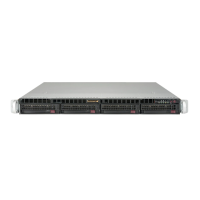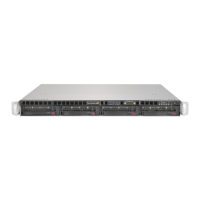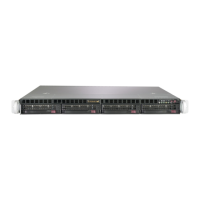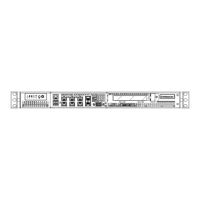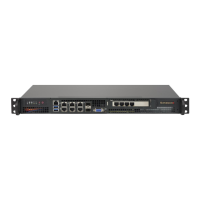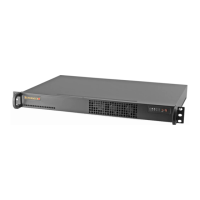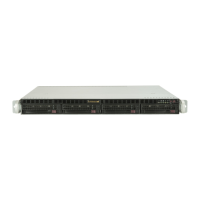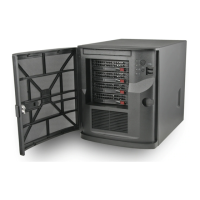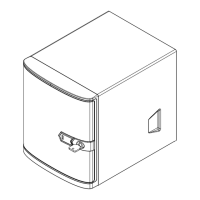Do you have a question about the Supermicro SuperServer 5019A-FTN4 and is the answer not in the manual?
Provides an overview of the manual's purpose and intended audience.
Lists important notes and links for drivers, utilities, and safety information.
Highlights symbols and warnings used throughout the manual.
Details the SuperServer 5019A-FTN4's main functions, features, and specifications.
Describes the front panel, control panel, and motherboard layout.
Covers choosing a location, rack mounting, and server safety precautions.
Discusses ambient temperature, airflow, mechanical loading, and circuit overloading.
Provides step-by-step instructions for securing the chassis into a rack unit.
Guides on safely removing power and accessing internal system components.
Instructions for installing memory modules and the motherboard battery.
Procedures for installing hard drives, expansion cards, cooling, and power supply.
Details the main ATX, 4-pin HDD, and 4-pin DC power connectors.
Explains fan headers, I/O ports, COM header, and various LED indicators.
Describes the function and settings of various jumpers and switches on the motherboard.
Step-by-step guide for installing Windows OS on RAID and non-RAID systems.
Instructions for downloading and installing system drivers and utilities.
Overview of SuperDoctor 5 for monitoring and IPMI for remote management.
Introduction to BIOS utility and main setup screen options like date, time, and version.
Covers boot features, CPU, chipset, memory, and I/O configurations.
Details BIOS security, boot order, and save/exit options.
Lists common POST beep codes for system errors and their meanings.
Procedures for recovering the UEFI BIOS image using USB devices.
Provides a detailed list of system components and their technical specifications.
Specifies the recommended operating and non-operating temperature and humidity.
Lists compliance standards for electromagnetic emissions, immunity, and safety.
Includes perchlorate and other specific product warnings.
Explains warning symbols and definitions for potential hazards.
Illustrates and explains safety symbols for warnings and cautions.
| Processor family | Intel |
|---|---|
| Processor socket | BGA 1310 |
| Built-in processor | No |
| Motherboard chipset | Intel SoC |
| Number of processors supported | 1 |
| ECC | Yes |
| Memory voltage | 1.2 V |
| Maximum RDIMM memory | 128 GB |
| Maximum UDIMM memory | 64 GB |
| Number of DIMM slots | 4 |
| Supported memory types | DDR4-SDRAM |
| Supported RDIMM clock speeds | 1600, 1866, 2133, 2400 MHz |
| Supported DIMM module capacities | 4GB, 8GB, 16GB, 32GB |
| Storage drive sizes supported | 2.5, 3.5 \ |
| Supported storage drive interfaces | Serial ATA III |
| Ethernet LAN data rates | 10, 100, 1000 Mbit/s |
| Ethernet interface type | Fast Ethernet, Gigabit Ethernet |
| Copper ethernet cabling technology | 10BASE-T, 100BASE-TX, 1000BASE-T |
| USB 2.0 ports quantity | 2 |
| PCI Express slots version | 3.0 |
| On-board graphics card model | Aspeed AST2400 |
| BIOS type | UEFI AMI |
| ACPI version | 5.0 |
| BIOS features | Plug & Play, SMBIOS 2.7.1, UEFI |
| Chassis type | Rack (1U) |
| Fan diameter | 40 mm |
| Product color | Black |
| Number of fans | 2 fan(s) |
| Storage temperature (T-T) | -40 - 70 °C |
| Operating temperature (T-T) | 0 - 40 °C |
| Storage relative humidity (H-H) | 5 - 95 % |
| Operating relative humidity (H-H) | 8 - 90 % |
| Power supply | 200 W |
| AC input voltage | 100 - 240 V |
| AC input frequency | 50 - 60 Hz |
| DC output current (+5 V) | 8 A |
| DC output current (+12 V) | 16 A |
| Sustainability certificates | RoHS |
| Harmonized System (HS) code | 84714100 |
| Depth | 249 mm |
|---|---|
| Width | 437 mm |
| Height | 43 mm |

